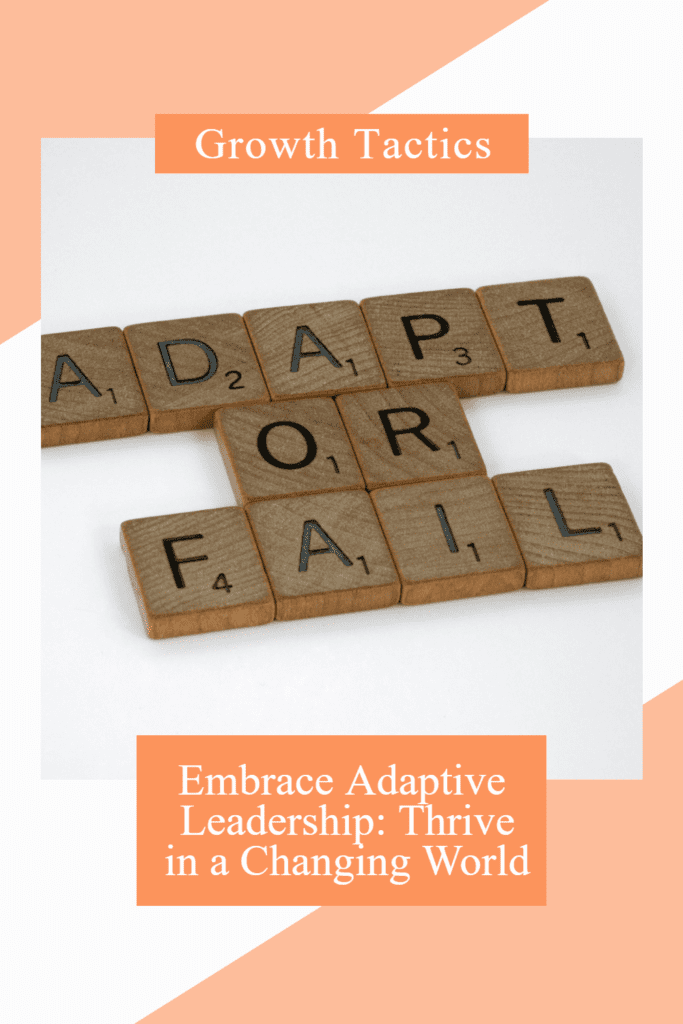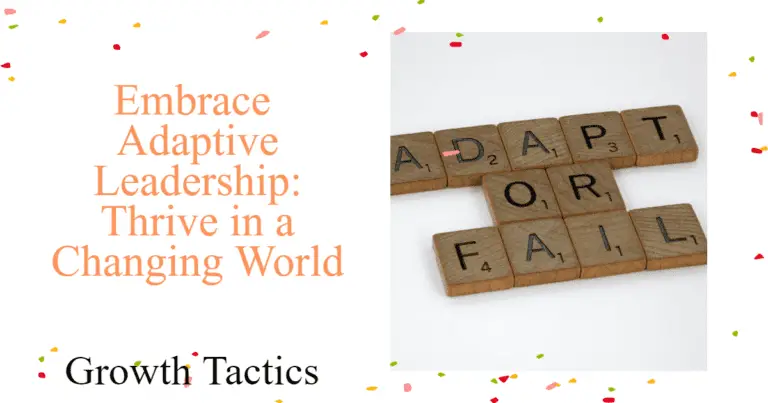Have you ever felt stuck when facing a tough problem at work? I sure have. That’s where adaptive leadership comes in handy. It’s a powerful way to lead that can help you and your team tackle any challenge.
Jump To Section
What is Adaptive Leadership?
Adaptive leadership is all about being flexible and ready to change. It’s like being a surfer who rides different waves instead of trying to control the ocean. As someone who’s led teams through ups and downs, I can tell you that this approach works wonders.
Here’s the deal: the world is always changing. What worked yesterday might not work today. Adaptive leaders get this. They don’t stick to old ways just because “that’s how we’ve always done it.”
The Story of Adaptive Leadership: A Game-Changer in Leading Teams
Adaptive leadership isn’t new, but it got its name in the 1990s. Two guys at Harvard, Ronald Heifetz and Marty Linsky, came up with the idea. They saw that the old ways of leading weren’t working for new problems.
These Harvard guys said leaders need to be flexible. They need to help their teams change with the times. It’s not about having all the answers. It’s about helping your team find the answers together.
Over the years, more people started talking about adaptive leadership. They saw how it could help in all kinds of situations. Business, politics, even in our personal lives. This way of thinking works everywhere.
Today, adaptive leadership is more important than ever. The world changes fast, and we need to keep up. It’s not always easy, but it’s exciting. Every day brings new challenges and chances to grow.
Why Adaptive Leadership Matters
In my years of leading teams and tackling tough challenges, I’ve learned that adaptive leadership isn’t just a fancy term, it’s a game-changer. Let me tell you why it matters so much.
It Helps You Solve Tricky Problems
Life throws curveballs. Adaptive leaders don’t get stuck. They look at problems from different angles and aren’t afraid to try new approaches. It’s like having a Swiss Army knife instead of just a hammer.
It Makes Your Team More Creative
I’ve seen quiet team members come alive when given the chance to adapt. Once, during a project that was going nowhere, I asked everyone to think outside the box. The ideas that came out were amazing!
When you lead adaptively, you’re telling your team it’s okay to experiment. You’re giving them permission to be creative. And trust me, that’s when the magic happens.
It Keeps Your Business Ahead of the Curve
The business world moves fast. What worked yesterday might not work tomorrow. I learned this the hard way when my old-school supervision tactics stopped working.
Adaptive leaders keep their eyes open. They spot trends early and aren’t afraid to change course. It’s like surfing, you’ve got to move with the waves, not against them.
It Builds Resilience
Life isn’t always smooth sailing. I’ve had my share of setbacks, and adaptive leadership has been my lifeline. It teaches you and your team to bounce back stronger.
When you adapt, you’re showing that challenges are just pit stops, not dead ends. This mindset is powerful. It turns potential failures into stepping stones for success.
It Encourages Personal Growth
Here’s something I love about adaptive leadership: it pushes you to grow. Every time you adapt, you learn something new about yourself and your capabilities.
I’ve seen team members discover hidden talents when faced with new challenges. It’s like they’re unlocking new levels in a video game, each one making them stronger and more confident.
So, why does adaptive leadership matter? Because it prepares you for whatever comes your way. It turns problems into opportunities. It makes your team stronger, your business smarter, and you a better leader.
How to Be an Adaptive Leader
Being an adaptive leader isn’t about having all the answers. It’s about asking the right questions and being open to new ideas. Here are some tips I’ve picked up along the way:
Listen More Than You Talk
Your team has great ideas. Give them a chance to shine. I remember when I first started leading teams, I thought I had to have all the solutions. Boy, was I wrong!
Active Listening
Practice active listening. This means really focusing on what others are saying, not just waiting for your turn to speak. I’ve found that nodding and asking follow-up questions shows you’re truly engaged.
Create Safe Spaces
Make sure your team feels safe sharing their thoughts. I like to have regular “no-bad-ideas” brainstorming sessions. It’s amazing what people come up with when they’re not afraid of being judged.
Embrace Change
Don’t fear change, see it as a chance to grow. This one was tough for me at first, but it’s been a game-changer.
Reframe Your Mindset
Instead of thinking “Oh no, things are changing,” try “Great, here’s a chance to learn something new!” It’s all about how you look at it.
Be Flexible
Plans change, and that’s okay. I’ve learned to have a Plan B (and sometimes a Plan C) ready to go. It helps me feel more prepared and less stressed when things shift.
Encourage Experiments
Not every idea will work, but that’s okay. We learn from failures too. In fact, some of my biggest lessons have come from ideas that flopped.
Create a “Failure-Friendly” Environment
Let your team know it’s okay to try new things, even if they don’t always work out. I like to celebrate the effort and learning, not just the successes.
Learn from Mistakes
When something doesn’t go as planned, don’t point fingers. Instead, ask “What can we learn from this?” It turns setbacks into stepping stones.
Stay Curious
Always be learning. The world won’t stop changing, so neither should you. This is probably my favorite part of being an adaptive leader.
Read Widely
I try to read something new every day, even if it’s just for 15 minutes. It keeps my mind fresh and often gives me ideas I can apply at work.
Ask Questions
Don’t be afraid to say “I don’t know” or ask for explanations. I’ve found that people respect leaders who are willing to learn.
Real-Life Examples of Adaptive Leadership in Action
I’ve always been fascinated by how great leaders adapt to challenges. Let’s look at some famous people and teams who’ve shown us what adaptive leadership really means.
Nelson Mandela: Turning Enemies into Allies
Nelson Mandela amazes me. After 27 years in prison, he could’ve been angry. Instead, he chose to work with his former enemies. He adapted his approach to unite South Africa.
He even invited his former jailer to his inauguration. It shows me that true leadership is about bringing people together, not pushing them apart.
Apple: Changing Direction to Stay on Top
Apple’s a great example of a company that adapts. When Steve Jobs came back in 1997, Apple was struggling. Instead of sticking to old ways, Jobs led the company in a new direction.
He focused on making fewer, better products. This shift gave us the iPod, iPhone, and iPad. It’s a reminder that sometimes, doing less can actually lead to more success.
Malala Yousafzai: Adapting to New Challenges
Malala’s story always inspires me. She started as a young activist for girls’ education in Pakistan. After surviving an attack, she adapted her approach to reach a global audience.
Malala didn’t let fear stop her. She used her new platform to fight even harder for education. It shows that true leaders can turn setbacks into opportunities.
Airbnb: Pivoting in a Crisis
I’ve been amazed by how Airbnb handled the COVID-19 crisis. When travel stopped, their business was hit hard. But instead of giving up, they got creative.
They launched “Online Experiences,” letting people enjoy virtual tours and virtual classes from home. They also focused on long-term stays for remote workers. This quick pivot helped them survive and even thrive during tough times.
These examples remind me that adaptive leadership isn’t about having all the answers. It’s about being open to change and finding new ways to reach your goals. What challenges are you facing? How could you adapt your approach?
Remember, every leader’s journey is unique. These stories aren’t blueprints to follow exactly. They’re inspirations to help you find your own path. What matters most is staying true to your purpose while being flexible in your methods.
Your Turn to Adapt
Remember, adaptive leadership isn’t just for CEOs or managers. Anyone can be an adaptive leader. It’s about how you approach problems and work with others.
So, next time you face a tough situation, try something new. Be open to change. Listen to different viewpoints. You might be surprised at what you can achieve.
Are you ready to become an adaptive leader? Trust me, it’s a game-changer. Give it a shot and see how it transforms your work and your life.


